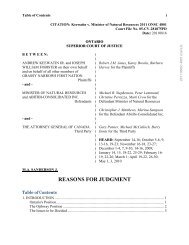Omers Energy Inc. v. Alberta (Energy Resources Conservation Board)
Omers Energy Inc. v. Alberta (Energy Resources Conservation Board)
Omers Energy Inc. v. Alberta (Energy Resources Conservation Board)
- No tags were found...
Create successful ePaper yourself
Turn your PDF publications into a flip-book with our unique Google optimized e-Paper software.
Page: 4that a very low, or even nonexistent threshold, would offer little or no incentive for a lessee toundertake and maintain operations to recover leased substances. Moreover, it could result in onlya nominal return to the lessor for an indeterminate length of time without any obligation on thelessee to rectify the situation. Such an interpretation was, in the <strong>Board</strong>’s view, contrary to theintention of the parties as expressed throughout the lease as a whole.[19] The <strong>Board</strong> held, therefore, that “capable of producing the leased substances” required morethan a minuscule amount of production. Rather, it found that the volume of production needed tobe material or meaningful before the lessee could rely on the Suspended Wells Clause to extend thelease (<strong>Board</strong> Decision 9). Furthermore, the <strong>Board</strong> concluded that “capable of producing” referredto the well in its present state. It rejected the idea that a well could be “capable of producing theleased substances” and at the same time be in need of an operation to address a situation such aswater loading (<strong>Board</strong> Decision 13). The <strong>Board</strong> found that this type of remedial requirement fellwithin the definition of “operations” under Clause 1(g) of the Cymbaluk Lease, and that a well couldnot be both capable of production and in need of operations of that type at the same time.[20] The <strong>Board</strong> concluded:“[C]apable of producing the leased substances” is to be interpreted to meanthe demonstrated, present ability of a well on the lands to produce the leasedsubstances in a meaningful quantity within the timeframes contemplated inthe lease. The <strong>Board</strong> emphasizes that what is “material” or “meaningful”depends on the relevant factors in each individual case. In this case, the termsof the Cymbaluk lease coupled with the evidence of the well’s capability toproduce, as set out below, are determinative of the issues in this proceeding.(<strong>Board</strong> Decision 9)[21] Finally, the <strong>Board</strong> turned to whether the 100/05-4 Well met this test. After reviewing theevidence on the well’s capabilities, the <strong>Board</strong> concluded that the well had not produced a meaningfulquantity of gas since March 28, 2006 when the wellbore filled with water. Nor had the well beencapable, since that date, of emitting gas without further operations to clear the water out of thewellbore – with the result that it did not have the present ability to produce. The <strong>Board</strong> concluded,therefore, that the well was not capable of producing the leased substances.[22] Although the lease had been preserved by clean out operations on May 9, 2006, the welldepleted in 13 seconds and no further operations were conducted until November 9, 2006 – a periodof more than 90 days without operations being conducted. As a result, the <strong>Board</strong> concluded the leasehad not been extended by further operations and had expired on May 10, 2006, the day after the lastoperations had been conducted. As the lease had expired, the <strong>Board</strong> upheld the suspension of the twowell licences.
















